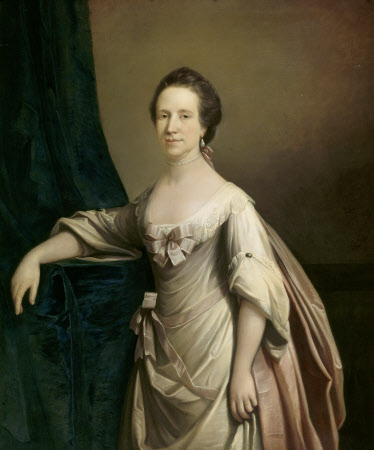Bethia Legge, Mrs Richard Willis (1734-1778)
Robert Edge Pine (London 1730 – Philadelphia 1788)
Category
Art / Oil paintings
Date
circa 1760
Materials
Oil on canvas
Measurements
1270 x 1016 mm (50 x 40 in)
Place of origin
England
Order this imageCollection
Clevedon Court, North Somerset
NT 624177
Summary
Oil painting on canvas, Bethia Legge, Mrs Richard Willis (1734-1778) by Robert Edge Pine (London 1730 – Philadelphia 1788), circa 1760. (formerly attributed to Francis Cotes). She was daughter and heiress of William Legg of Atherfield, I.O.W. Married Richard Willis (1724-1780); parents of James Legge Willis (1761-1817) who was the father of Rhoda Susan Willis (1809-1873) who married, as his first wife, Sir Arthur Hallam Elton, 7th Bt, MP (1818-1883). Portrait of a young woman, three-quarter length, standing, turned slightly to the left, gazing at spectator, her right arm resting on a draped ledge her left arm by her side. She has dark brown hair, swept back, a drop pearl earring, a pearl necklet, tied at the back with a ribbon. She wears a cream/grey silk dress the sleeves pinnned back with small jewels, a lace collar and a large bow at her breast. Her dress is looped to her right hip and a pale pink cloak can just be discerned draped at the back.
Provenance
Bequest of Colonel Richard ffolliot Willis, 1956 formerly lent to Lydiard Tregoze, Swindon; transferred to Clevedon Court in 1984
Credit line
Bequest of Col. Richard ffolliot Willis, 1956 formerly lent to Lydiard Tregoze, Swindon; transferred to Clevedon Court
Makers and roles
Robert Edge Pine (London 1730 – Philadelphia 1788), artist previously catalogued as circle of William Hoare of Bath, RA (Eye 1707 – Bath 1792), artist previously catalogued as attributed to British (English) School, artist
References
Waterhouse 1980: Ellis K. Waterhouse, 'The Willis Family Portraits at Lydiard Park' National Trust Studies, 1980, pp.49-53, p.51: Illus. Caption to illustration: "Bethia (Legg [sic]), Mrs Richard Willis (1735-78), canvas 127 cm x 101.6 cm." p.50: "The series of portraits begins with a pair of portraits of the great-great-grandfather of Colonel Willis [Colonel Richard ffolliott Willis (1875-1956)], and a companion pair of his wife. This Richard Willis (1724-80) (Fig.2), who was born in Cumberland, was a Turkey merchant of the Levant, and he married at St Olav's, Hart Street, in 1757, Bethia Legg (1734/5-78) (Fig.3), daughter of William Legg of Atherfield Manor, Isle of Wight. There is a pair of heads in crayons and a pair of half-length in oils (Figs 4 and 5), obviously from the same sittings as the heads and equally clearly by the same artist. The larger pictures bore an old label as by Ramsay, but this attribution was changed to 'probably by Cotes'. However, neither of these attributions is acceptable. They are obviously, in a sense, 'marriage portraits' but need not be quite as early as 1757 and a date not later than the early 1760s seems probable from the costume. The two painters who practised equally in oil and crayons who deserve to be considered are Robert Edge Pine and William Hoare, neither of which has been the object of very close research. I think Pine is the more probable, although they lack the mannerism by which his slightly later portraits can easily be recognised, a sort of slicing of the edge of the forehead which is in half shadow. Richard William went bankrupt in 1778, owing to the French Wars and was sent by his creditors to Grenada to settle his affairs there. He died of wounds received at the siege of Grenada in 1780.
